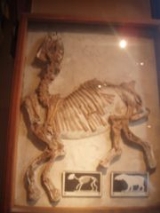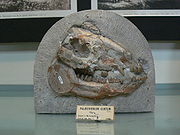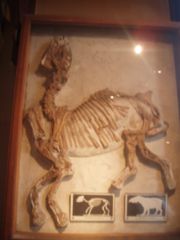
Palaeotherium
Encyclopedia



Ungulate
Ungulates are several groups of mammals, most of which use the tips of their toes, usually hoofed, to sustain their whole body weight while moving. They make up several orders of mammals, of which six to eight survive...
. George Cuvier originally described them as being a kind of tapir
Tapir
A Tapir is a large browsing mammal, similar in shape to a pig, with a short, prehensile snout. Tapirs inhabit jungle and forest regions of South America, Central America, and Southeast Asia. There are four species of Tapirs: the Brazilian Tapir, the Malayan Tapir, Baird's Tapir and the Mountain...
, and as such, Palaeotherium is popularly reconstructed as a tapir-like animal. Recent reexaminations of the skulls show that the nasal cavity was not designed to support a small trunk, thus starting a recent trend to reconstruct them as looking more horse
Horse
The horse is one of two extant subspecies of Equus ferus, or the wild horse. It is a single-hooved mammal belonging to the taxonomic family Equidae. The horse has evolved over the past 45 to 55 million years from a small multi-toed creature into the large, single-toed animal of today...
-like. Recent anatomical studies also suggest that Palaeotherium, along with other palaeothere genera such as Hyracotherium
Hyracotherium
Hyracotherium , also known as Eohippus or the dawn horse, is an extinct genus of very small perissodactyl ungulates that lived in the woodlands of the northern hemisphere, with species ranging throughout Asia, Europe, and North America during the early Tertiary Period and the early to mid Eocene...
, were closely related to horses.
The average species of Palaeotherium was about 75 cm (2 ft 6 in) tall at the shoulder and lived in the tropical forests covering Europe
Europe
Europe is, by convention, one of the world's seven continents. Comprising the westernmost peninsula of Eurasia, Europe is generally 'divided' from Asia to its east by the watershed divides of the Ural and Caucasus Mountains, the Ural River, the Caspian and Black Seas, and the waterways connecting...
around 45 million years ago, during the early to mid Eocene
Eocene
The Eocene Epoch, lasting from about 56 to 34 million years ago , is a major division of the geologic timescale and the second epoch of the Paleogene Period in the Cenozoic Era. The Eocene spans the time from the end of the Palaeocene Epoch to the beginning of the Oligocene Epoch. The start of the...
. The largest species, P. magnum of Mid Eocene France
France
The French Republic , The French Republic , The French Republic , (commonly known as France , is a unitary semi-presidential republic in Western Europe with several overseas territories and islands located on other continents and in the Indian, Pacific, and Atlantic oceans. Metropolitan France...
, grew to be almost as large as a horse.

